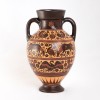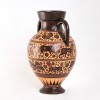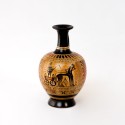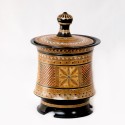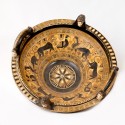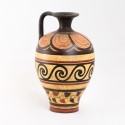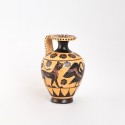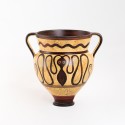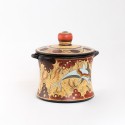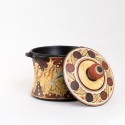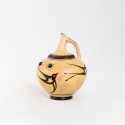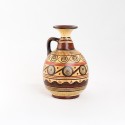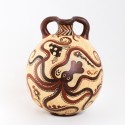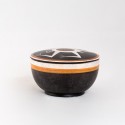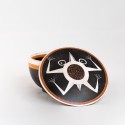
CORINTHIAN AMPHORA - CORV058COD87
Handmade ceramic Amphora of Oriental Rhythm (Corinthian), around 600 BC.
Price: 390.00€
Handmade Corinthian ceramic amphora decorated with overlapping belts with animals and plant jewelry
The dominant element of the rhythm fauna is the chamois. In addition to chamois there are sphinxes, rooster lions and geese. The term amphora means an oval vessel with a vertical handle on both sides. It was used to store wine and sometimes oil. The name amphora comes from the adverb amphi and the verb carry
Dimensions: cm. HEIGHT
Description: Masterpiece handmade ceramic amphora decorated with overlapping belts with animals and plant jewelry
The dominant element of the rhythm fauna is the chamois. In addition to chamois there are sphinxes, swallows and geese.
The commercial amphorae of Corinth are an eloquent testimony to the export activity of Corinth, mainly wine and oil. The most characteristic type is the so-called Amphora type A, which is considered an evolution of the large storage vessels of the geometric period. The commercial amphorae appear from the end of the 8th c. e.g. and continue until the end of the 4th c. e.g. They are mainly handmade and are widespread in the coastal settlements of Sicily and Greater Greece from the end of the 8th and throughout the 7th century. e.g. These vessels were also widely used in infant burials, the so-called incisions.
The most important pottery workshop during the 7th century BC. It was that of Corinth, both in terms of the innovations and ingenuity it displayed, and in terms of the spread of its vessels, and therefore the influence it exerted on the other centers. In Corinth the transition from geometric to oriental patterns took place very early, apparently because the city had developed commercial activities and a great familiarity with eastern crafts.
. The predominance of naturalistic tendencies found fertile ground in the cultivated sense of miniature precision of the Corinthian angiographers. The technique that allowed the decoration of small vessels - such as the spherical aryvals and the acorns - was an invention of the Corinthian angiographers and was called the black-figure technique
In this form it was designed as a silhouette, but before baking the details were carved with a sharp tool while removing a thin strip of varnish. Production in Corinthian Ceramics is divided into two major periods with several subcategories. Each period lasted about a century: the First Corinthian period from 720 to 625 BC. and the Corinthian from 625 to 535 BC
. Apart from the chamois, you can find dogs, lions, sphinxes, griffins, hares and more rarely wild boars, rams and foxes. Human forms are extremely rare. Geometric jewelry, such as the chessboard, is preserved from the previous decorative tradition, but new ones are also introduced, such as the radial at the base of the vases and the current spiral in various zones. At the average rate I, the oinochoe is adopted with a wide mouth and a low spherical body, about 30 cm high, but later the clover-shaped one prevails. Rare shapes are the disc with a high conical foot, the crater and the cup in the shape of the sub-geometric goblet with birds. The forms are found on the shoulder and in the abdomen of the vessel and more rarely, in the first type of winemaker, and on the neck. The fauna is growing: outside the chamois, deer with spotted skin, bulls, panthers and mainly geese are now appearing. The swallow also plays a complementary role. The survival of the hypogeometric influences is observed in the decorative motifs.
Our personal love and interest in Archaic art, combined with our long experience in the field of painting for more than 40 years, guarantees the excellent result of our work.
We work with the best Greek potters in order to ensure the creation of an excellent ceramic utensil.
Then it is our turn to turn this vase into a work of art.
In our privately owned facilities we personally focus on each piece and follow as closely as possible the ancient Greek techniques for painting and decorating each ceramic.
What you will eventually receive is a unique work of art that will stand proudly in your collection.
HAND MADE AND PAINTED IN GREECE
It is only a decorative and not a useful object.




